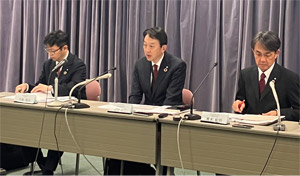Top of page.
- Skip the menu to main contents.
Link for header starts here.
![]()
Page ends here.
Financial Results Announcement (October 31, 2023)

JAL announced its financial results for the second quarter of fiscal year 2023.
Here is a summary of the press conference.
< Financial results for the second quarter of fiscal year 2023 >
I would like to explain our business results for the second quarter of fiscal year 2023.
First, let me give you an overview of our consolidated financial results.
For the second quarter of the fiscal year ending March 31, 2024, we steadily captured the recovering passenger demand, posting a revenue of 820.9 billion yen and a positive EBIT of 91.2 billion yen. Net profit was also positive at 61.6 billion yen, continuing the first quarter's result in increasing both revenue and profit compared to FY19 before the COVID-19 pandemic.
I will explain the situation for each business domain.
Regarding full-service carrier (FSC), strong inbound demand in international passenger operations continued to contribute to revenue growth. Outbound demand from Japan has returned and is expected to steadily recover in the future. As for domestic passenger operations, despite the impact of typhoons in August, we were able to secure revenues on par with 2019 due to improved revenue per passenger.
As a result, international passenger revenue for the first half of the fiscal year totaled 314.4 billion yen, increasing 151.1 billion yen from the previous fiscal year. Domestic passenger revenue totaled 275.0 billion yen, increasing 66.4 billion yen from the previous fiscal year.
Cargo and mail decreased by 59.3 billion yen from the previous year to 66.9 billion yen. Although the tightness of global supply-demand has been resolved, revenues remained above the pre-COVID-19 levels by focusing on the transportation of high value-added cargo and maximizing volume.
In the low cost carrier (LCC), ZIPAIR performed well, with total passengers exceeding 1 million in September, and EBIT for the LCC as a whole was 2.7 billion yen.
In terms of expenses, although there was an increase in expenses linked to the recovering number of total passengers and scale of operations, we continued to work on thorough cost control and kept operating expenses below the increase in production volume.
Next, I would like to explain our consolidated financial position and cash flow situation as of the end of this period.
As of the end of the second quarter, the shareholders' equity ratio based on credit rating evaluation considering Hybrid Finance was 39.8 percent, and the net debt-to-equity ratio was 0.0 times, both maintained at healthy levels. Cash and deposits on hand as of the end of September amounted to 743.5 billion yen, with liquidity on hand also at a healthy level. Operating cash flow for the first half of the year totaled 213.4 billion yen, an increase of 93.1 billion yen from the previous fiscal year.
Regarding our most recent initiatives, as we have recently announced its specifications, we plan to launch a new signature aircraft, the Airbus A350-1000, on the Haneda-New York route by the end of this year. Please look forward to this as we plan to increase the number of aircraft in the fleet.
Now I will explain our earnings forecast for this period of the current fiscal year.
The consolidated financial results forecast for this period in the current fiscal year, reflecting the recent recovery in passenger demand and other factors, has been revised upward to a revenue of 1,684.0 billion yen, EBIT of 130.0 billion yen, and net profit of 80.0 billion yen.
In revising the earnings forecast, we have revised our assumptions for Singapore Kerosene to 120 U.S. dollars per barrel and the exchange rate to 145 yen per U.S. dollar.
Revenue is expected to exceed the initial forecast by 26 billion yen, reflecting the strong passenger demand and the current status of the cargo and mail.
Expenses are expected to decrease by 4.0 billion yen from the initial forecast, reflecting a decrease in fuel expenses in the first half of the year from the initial forecast, among others. For the full year, fuel expenses are expected to decrease by 10.0 billion yen and expenses other than fuel expenses are expected to increase by 6.0 billion yen from the initial forecast.
Although there are uncertainties such as fuel prices, we will take every possible measure to maximize profits by increasing passenger revenues by capturing strong demand and continuing cost reduction efforts.
Finally, I would like to explain about dividends.
In line with the upward revision of our earnings forecast, we have increased our annual dividend forecast from 40 yen to 60 yen per share. Of this amount, we have decided to pay an interim dividend of 30 yen per share. We will strive to achieve continuous and stable shareholder returns in line with the recovery of our business performance, which has been our basic policy, and aim to achieve a dividend payout ratio of 35 percent or more after generating a sufficient level of profit.
With the support of our stakeholders, we have managed to improve our business performance and are pleased to announce an increase in dividends. We would like to take this opportunity to thank you again.
We will continue to provide the best possible service to our customers and strongly promote the business structure reforms set forth in our Medium-Term Management Plan, and we will make concerted efforts to live up to everyone's expectations.